Foreclosure-Related Vacancy Rates
The national foreclosure crisis has caused there to be millions more vacancies in our housing stock than before. Vacant homes lower their community’s property values and quality of life. Neighbors and public officials know foreclosed homes sit empty for months, but precise measures of foreclosure-related vacancy are rare. Using data from Cuyahoga County, Ohio, I trace the rise and fall in the vacancy rates of homes during the 18 months following their foreclosure. Ominously, the data suggest that foreclosure may permanently scar some homes. Foreclosed homes still have higher vacancy rates than neighboring houses two to five years after a sheriff’s sale.
The national foreclosure crisis has caused there to be millions more vacancies in our housing stock than before. Vacant homes lower their community’s property values and quality of life. Neighbors and public officials know foreclosed homes sit empty for months, but precise measures of foreclosure-related vacancy are rare. Using data from Cuyahoga County, Ohio, I trace the rise and fall in the vacancy rates of homes during the 18 months following their foreclosure. Ominously, the data suggest that foreclosure may permanently scar some homes. Foreclosed homes still have higher vacancy rates than neighboring houses two to five years after a sheriff’s sale.
As the housing market staggers into its fifth year of decline, the issues of foreclosure and vacancy continue to demand our attention. In 2010, 1.85 million consumers nationwide received a new foreclosure notice, compared to between 600,000 and 800,000 in the “normal” times of a decade earlier.
Almost all foreclosed homes are at least temporarily vacant; as long as they remain so, they impact the home values and quality of life in their neighborhoods. What if the vacancy associated with foreclosure lingers on long after the foreclosure? Could the rise in foreclosures translate into both a short- and a long-term increase in vacancy?
Using a unique data set covering Cuyahoga County, Ohio, I explore whether foreclosed homes are reoccupied at rates similar to those of other recently sold homes. The data reveal that foreclosed homes go through more than a year of very high vacancy rates following the auction and are substantially more likely to be vacant up to 60 months after the foreclosure.
The distribution of foreclosures is heavily weighted toward high-poverty areas, and homes in these areas are more likely to be vacant long after they are sold. However, even compared to homes in census tracts with similar poverty levels, foreclosed homes show higher vacancy rates than others years after the auction.
The Impact of Vacancy
Foreclosure and the vacancy it causes are a concern for policymakers because a foreclosure’s impact extends to hundreds of people in the neighboring community. A foreclosure adds one more home to the supply on the market and so depresses the prices of all homes sold in the area. This leads to smaller gains or larger losses for people who must sell in the current market and devalues the largest asset most households own—their house. This lower value limits homeowners’ ability to extract equity for expenses such as home improvements, starting a business, college tuition, or retirement. Owners of depreciated homes may constrain their spending to try to make up for the lost wealth, and this can act as a drag on economic growth.
A vacant home can also lower property values, even if it is not for sale. Vacant homes are often part of a “shadow inventory” because the owners intend to put them on the market when demand recovers. Every month, some of these owners will decide that the costs of holding an empty house outweigh the benefits of waiting. In locations with a lot of shadow inventory in addition to the active inventory, there is downward pressure on home prices.
Moreover, the exterior of a vacant home is usually less likely to be well-maintained than an occupied one. This detracts from the vitality of the neighborhood and the prices buyers are willing to pay for nearby homes. In high-crime areas, unoccupied homes are often broken into, stripped of valuable metals, and vandalized. In some cases, criminals move into the homes and run illegal operations from them.
As foreclosures have increased in recent years, so have the studies that estimate their economic impact. It is not surprising that economists have been able to detect a distinct difference in prices for homes near a recently foreclosed property. John Harding, Eric Rosenblatt, and Vincent Yao used data from seven metro areas to estimate the impact of a foreclosure on the sale prices of nearby homes. Their results suggest that a distressed property within 300 feet of a home sale will lower the sale price by 1 percent. John Campbell, Stefano Giglio, and Parag Pathak report a similar finding in their study, which analyzes two decades of sales records from Massachusetts. They observe that a foreclosure within 264 feet reduced the sale price of a house by 1 percent. These two studies build on a list of similar published findings.
In articles on foreclosure, authors usually note that foreclosures lead to vacancies, which can depress sales prices through the supply and disamenity channels discussed above. A study by the Federal Reserve Bank of Cleveland’s Dan Hartley estimates the strength of the two channels separately. He finds that foreclosures in high-vacancy neighborhoods depressed prices by 2 percent via a disamenity effect, whereas foreclosures in low-vacancy neighborhoods depressed prices by 1.6 percent via a supply effect.
Parcel-level foreclosure data are widely available because the process must be recorded in court and property records. Data on the vacancy of individual homes are more difficult to obtain, so only one study so far has estimated the impact of vacant homes on nearby property values. Brian Mikelbank used data, collected by the City of Columbus, which identified vacant and abandoned homes along with foreclosures. He estimated that a vacant home reduced the sale price of nearby homes by 3.6 percent in the year following the city’s survey. Controlling for vacancies reduced the estimated impact of the foreclosures, reflecting the strong relationship between the two. Anecdotal information and aggregate figures suggest that foreclosures cause additional vacancies, but the relationship needs further study using data on individual properties.
A Study of One Ohio County
To study whether foreclosure increases the length of time homes stay vacant, a set of data have to be constructed. I focused on Cuyahoga County, a populous counties hit hard by the foreclosure crisis. I used county sales records from 2006 to 2010, and for vacancy data, I used the U.S. Postal Service’s address database. Homes are recorded as vacant in the USPS database if they have been vacant for at least 90 days. Actual vacancy rates are likely higher because there are many short-term vacancies that are not captured in this data.
The vacancy observations used in this analysis were all made in 2010. Figures that represent how many homes are vacant four or five years after a sale are calculated by taking homes that were sold in 2006 and observing whether they were vacant in 2010. Likewise, the vacancy rates calculated for the months close to a sale are based on sales in 2009 and 2010. The housing units are included in every month-difference group where it is possible to observe both sales and vacancies. Altogether, the calculations involve 85,000 properties and 130,000 sales transactions. I considered a sale a foreclosure if the transaction is recorded as a sheriff’s sale.1
As to the question of whether foreclosed homes are more likely to be vacant after the sale, the simplest answer is yes. Six to nine months before the sale, the occupancy rates of both types of homes are essentially the same (figure 1). By the date of the sale, the homes in foreclosure are already more likely to be in an extended period of vacancy. After the sale, there is a sharp contrast: Homes sold through ordinary transactions are occupied by their new owners within a few months. Vacancies among the foreclosed homes increase during the same period.
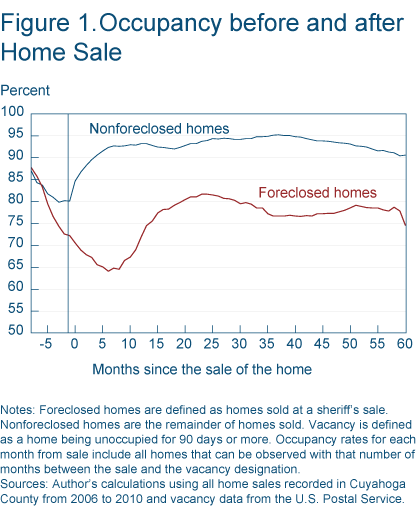
Notes: Foreclosed homes are defined as homes sold at a sheriff's sale. Nonforeclosed homes are the remainder of homes sold. Vacancy is defined as a home being unoccupied for 90 days or more. Occupancy rates for each month from sale include all homes that can be observed with that number of months between the sale and the vacancy designation.
Sources: Author's calculations using all home sales recorded in Cuyahoga County from 2006 to 2010 and vacancy data from the U.S. Postal Service.
At six months after a sheriff’s sale, a third of foreclosed homes are in an extended period of vacancy. The occupancy of foreclosed homes climbs between seven and 15 months after the sheriff’s sale, but it plateaus after that. In any month from two to five years after the sale, foreclosed homes are two to four times more likely to be vacant than those sold through ordinary transactions.
The Foreclosure Process and Vacancy
The connection between foreclosure and vacancy is built into the process and institutions. When a foreclosure auction is scheduled, the sheriff will physically remove the occupants of a home if they do not vacate voluntarily. Sheriff’s auctions differ from ordinary sales in that potential buyers have little or no access to the homes beforehand. Buyers receive no disclosure documents and cannot sue the previous owner if an important defect was not disclosed. In some states, there is even the possibility (perhaps remote) that the previous resident can reclaim the house up to a year after the sale if they can come up with funds to repay their debt.
All of these unknowns and risks strongly discourage individuals from purchasing a home to live in at a sheriff’s sale. Investors are willing to take the risk in some cases (17 percent of auction sales in the data). The vast majority (79 percent) of the top bidders at sheriff’s sales are banks or the federal agencies (Department of Housing and Urban Development, Department of Veterans Affairs, and government-sponsored enterprises Fannie Mae and Freddie Mac) that currently hold the mortgage.
When a bank purchases a home at sheriff’s sale, the property becomes “real estate owned” (REO) on the bank’s books. Banks generally hire real estate brokerages to market these homes. Although the brokerages enable potential buyers to inspect the homes, the banks still insist on selling the properties as-is. In exchange, they accept a lower price. Despite the discount, REO homes may spend more time vacant and on the market than other homes.
Offers from potential buyers must complete the bank’s approval process, which can take weeks. Also, any undesirable feature of a home can both lower its selling price and extend its time on the market. Foreclosed homes often are not maintained as well as others because the previous occupants were in financial distress and chose not to pay for repairs on a house they expected to lose. REO homes sit vacant while the processes of attracting a buyer and completing the sale move forward relatively slowly. In contrast, homeowner sellers usually do not move out until after the closing.
The REO process can explain most of the large gap between the occupancy rates of foreclosed and nonforeclosed homes in the first year after their sales. Figure 2 shows the percentage of homes that have a second sale recorded after the sheriff’s sale. The trends show that banks, investors, and nonprofits resell properties gradually over the 24 months after the auction. Federal Agencies unload most of their properties within a year, while individuals (just 4 percent of buyers) keep most of the properties they purchase.
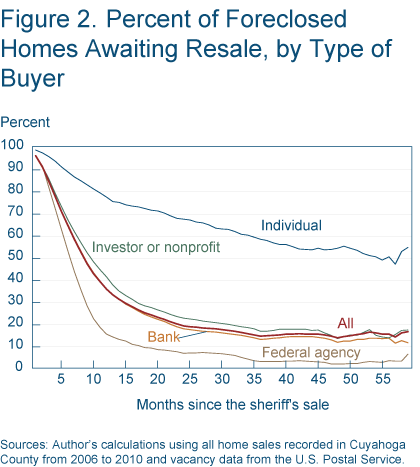
Sources: Author's calculations using all home sales recorded in Cuyahoga County from 2006 to 2010 and vacancy data from the U.S. Postal Service.
Investor-owned homes are not technically REO, but investors seem to behave like banks and to serve a similar purpose. Instead of filling sheriff’s-sale homes with tenants, investors are reselling them. Within two years, 75 percent of investor-purchased homes have been sold again. Just as banks buy their collateral out of the opaque auction market and then resell via broker viewings, investors are taking the risk of purchasing at auction and then reselling to buyers who can inspect the homes. The bank’s REO process reduces its losses, and the investors profit from an arbitrage. If investor-owned homes are undergoing renovations or being marketed, they are contributing to the high vacancy rate, just like bank- and agency-owned homes. A portion (12 percent to 14 percent) of bank- and investor-owned homes do not record a second sale within the time observed.
If we focus on the homes that exit REO status or are flipped, we still see a large difference between them and the nonforeclosed homes. Almost half of the previously auctioned homes are recorded in the data as having been vacant for 90 days or more at the time of their first sale after the sheriff’s sale (figure 3). The new owners reoccupy these homes at a similar pace following the sale, but they are starting at lower levels. Fourteen months after being resold, 80 percent of the homes are occupied. However, a plateau is visible in this series as well. Three to five years after their post-auction sale, approximately 20 percent of these homes are still vacant.
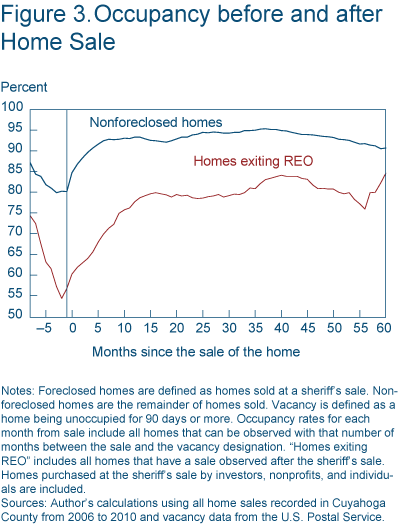
Notes: Foreclosed homes are defined as homes sold at a sheriff's sale. Nonforeclosed homes are the remainder of homes sold. Vacancy is defined as a home being unoccupied for 90 days or more. Occupancy rates for each month from sale include all homes that can be observed with that number of months between the sale and the vacancy designation. "Homes exiting REO" includes all homes that have a sale observed after the sheriff's sale. Home purchased at the sheriff's sale by investors, nonprofits, and individuals are included.
Sources: Author's calculations using all home sales recorded in Cuyahoga County from 2006 to 2010 and vacancy data from the U.S. Postal Service.
Home Characteristics and Vacancy
The REO process explains much of the difference in the vacancy rates of foreclosed and nonforeclosed properties, but not all. The type of homes that go into foreclosure have something to do with it as well. In general, lower-value homes are more likely to be vacant. More of the homes sold in sheriff’s sales are older and located in lower-income neighborhoods; 33 percent of nonforeclosed homes were built before 1941, compared to 61 percent of foreclosed homes; and 27 percent of nonforeclosed homes were located in high-poverty census tracts, compared to 60 percent of foreclosed homes. (A census tract is considered high poverty if at least 15 percent of its residents are living in households that fall below the official poverty threshold. A household’s poverty status depends on the number of people living there and the total household income.)
If we divide up the foreclosure observations according to their census tract’s poverty level, we observe that homes in middle- and upper-income areas are reoccupied almost to the same level as nonforeclosed homes (figure 4). The foreclosed homes in high-poverty areas are far less likely to be reoccupied at any time 18 to 60 months after the sheriff’s sale. The very high vacancy levels in high-poverty neighborhoods are partly a reflection of Cuyahoga County’s stagnant population. In some strong-market cities, such as New York or Los Angeles, surplus housing stock would be absorbed by new immigrants.
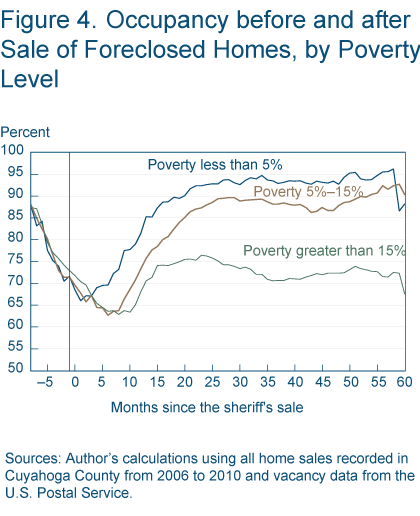
Sources: Author's calculations using all home sales recorded in Cuyahoga County from 2006 to 2010 and vacancy data from the U.S. Postal Service.
The Foreclosure Gap
At this point, we might be ready to say that foreclosure is just a temporary problem. Homes may be vacant while owned by banks or investors, but after that, they may return to the vacancy level that is normal for their age and area. However, there is one more angle on the data suggesting that foreclosure does have its own long-term impact. We can calculate a foreclosure gap—the difference between vacancy in foreclosed and nonforeclosed homes—within narrow categories. Figure 5 presents one such calculation.
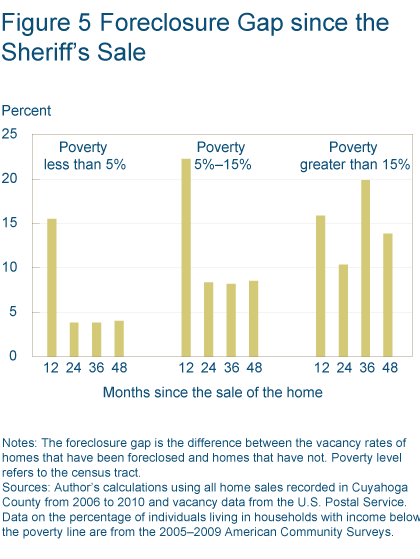
Notes: The foreclosure gap is the difference between the vacancy rates of homes that have been foreclosed and homes that have not. Poverty level refers to the census tract.
Sources: Author's calculations using all home sales recorded in Cuyahoga County from 2006 to 2010 and vacancy data from the U.S. Postal Service.
Data on the percentage of individuals living in households with income below the poverty line are from the 2005-2009 American Community Surveys.
In low-poverty census tracts, the gap is large at 12 months following the sale, as we would expect. The gap shrinks to less than 5 percent, but it persists for at least four years. Three or four additional points of vacancy may not seem like much until you consider that occupancy in low-poverty areas often exceeds 95 percent. This foreclosure gap could be doubling the probability of vacancy for homes in these areas. The pattern is similar in medium-poverty areas, but the gaps are bigger. After four years, foreclosed homes’ occupancy rates are 7 points lower than nonforeclosed homes’. In high-poverty areas, the foreclosure gap is large and does not trend downward. At any point between 12 and 48 months after a sale, foreclosure appears to add at least 10 points to the already high vacancy rate of homes in high-poverty areas.
Policy Implications
As the analysis here illustrates, homes that have been through a sheriff’s sale have very high vacancy rates for a year and a half afterward. The data strongly suggest that foreclosures leave long-lasting scars on some homes, where the foreclosure gap persists for years after the auction, even when the comparison is limited to homes in similar areas.
Given the literature that links foreclosure and vacancy to lowered property values, policymakers may want to address the process in at least two ways. First, keeping homes out of foreclosure would avoid creating REO and other vacancies that seem to linger among previously foreclosed homes.
Second, for homes that must go through foreclosure, any incentives or changes in administrative procedure that could shorten the time in REO would be helpful. As long as a home in REO status sits vacant, it diminishes the sales prices of all nearby homes on the market. The shorter this time is, the fewer homes will be affected.
However, as with all complex issues, policymakers need to be mindful of unintended consequences. For example, forcing banks to decrease the length of foreclosed homes’ time on the market could cause banks to lower sales prices, making the problem worse.
Footnote
- If a home has a sheriff’s sale anywhere in the data, it is not included in the vacancy calculations for nondistressed sales. It would be possible for the same property to contribute to the vacancy calculations based on two non-sheriff’s sales (in 2006 and 2008, for example). However, because the sale is linked with a vacancy observed in 2010, the same home could not contribute twice to a single months-from-sale vacancy rate unless it had two non-sheriff’s sales within one year. A second sale within a year is standard for foreclosed homes but very rare for never-foreclosed homes. Return
References Cited
- “Quarterly Report on Household Debt and Credit,” Federal Reserve Bank Of New York, 2011.
- “The Contagion Effect of Foreclosed Properties,” by John P. Harding, Eric Rosenblatt, and Vincent Yao, 2009. Journal of Urban Economics, 66(3): 164–78.
- “Forced Sales and House Prices,” by John Campbell, Stefano Giglio, and Parag Pathak. 2009. NBER working paper no. 14866.
- “The External Costs of Foreclosure: The Impact of Single-Family Mortgage Foreclosures on Property Values,” by Dan Immergluck and Geoff Smith, 2006. Housing Policy Debate, 17(1): 57–79.
- “Neighborhood Effects of Concentrated Mortgage Foreclosures,” by Jenny Schuetz, Vicki Been, and Ingrid Gould Ellen, 2008. Journal of Housing Economics, 17: 306–19.
- “The Effect of Foreclosure on Nearby Housing Prices: Supply or Disamenity?” by Daniel Hartley, 2010. Federal Reserve Bank of Cleveland working paper no. 10-11.
- “Spatial Analysis of the Impact of Vacant, Abandoned, and Foreclosed Properties,” by Brian Mikelbank, 2008. Federal Reserve Bank of Cleveland.
The views authors express in Economic Commentary are theirs and not necessarily those of the Federal Reserve Bank of Cleveland or the Board of Governors of the Federal Reserve System. The series editor is Tasia Hane. This work is licensed under a Creative Commons Attribution-NonCommercial 4.0 International License. This paper and its data are subject to revision; please visit clevelandfed.org for updates.
Suggested Citation
Whitaker, Stephan D. 2011. “Foreclosure-Related Vacancy Rates.” Federal Reserve Bank of Cleveland, Economic Commentary 2011-12. https://doi.org/10.26509/frbc-ec-201112
This work by Federal Reserve Bank of Cleveland is licensed under Creative Commons Attribution-NonCommercial 4.0 International
- Share




